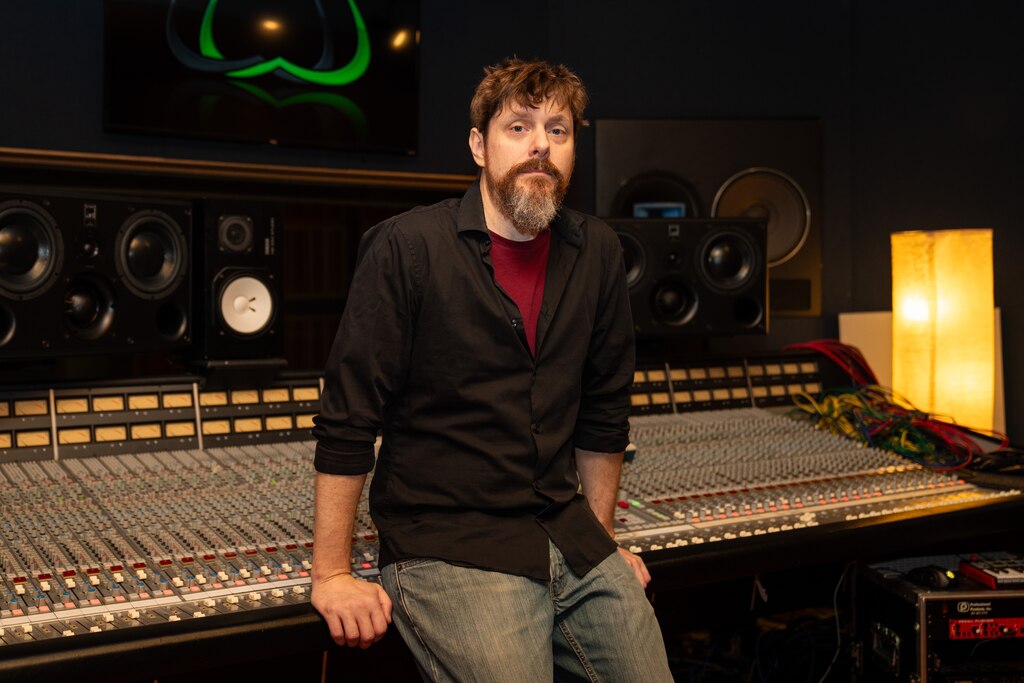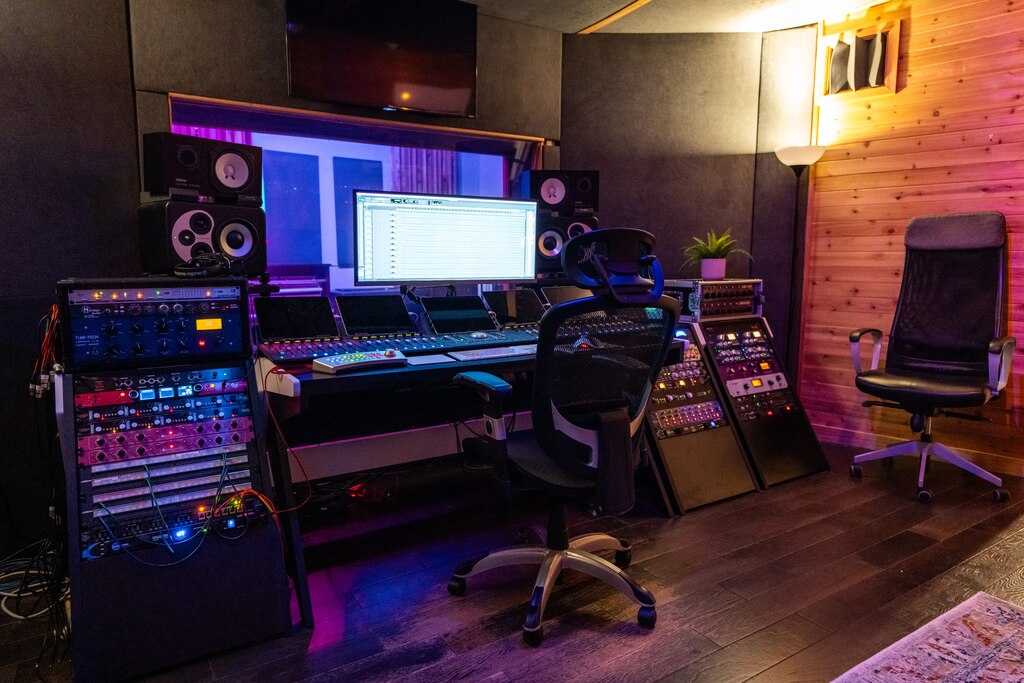“It’s not the biggest room in the world,” Steve Wright said as we walked into Studio A of Wright Way Studios, the Baltimore recording facility he’s run for over two decades. “But we can fit a 15-person orchestra in here.”
Sitting in Remington in the heart of the city, the studio has slowly grown since being built in the early ’90s. Hundreds of albums have been recorded here in just about every conceivable genre, including by a wide swath of local artists who helped shape the Baltimore music scene, but Wright has tended to shy away from doing press or boasting of accomplishments that might pigeonhole the space.
“Early on, I would say, ‘Hey look at what we did, look at what we did,’ and then I started noticing we were having problems,” he remembered. “People would be like, ‘Well, you’re the jazz studio, I can’t bring my rock project in there’ or ‘I don’t wanna bring my classical group in there because you don’t know how to do classical.” So the quality of the work has become Wright Way’s brand. “I want people to say ‘Oh, wow, they capture the artist, they figure out the sound of the artist, it sounds great, and it’s a high quality production.’”
Studio founder Arnie Geher can recall the exact date he began recording in what was then known as High Heel Studios. “On Aug. 1, 1990, we had our first session there. The place was so new we hadn’t even put the glass into the windows between the control room and the studio,” Geher said over the phone from Port Huenene, California, where he now lives.
Geher developed High Heel first as a home studio in his parents’ Owings Mills home in the mid-’80s, building on his connections in the Baltimore rock scene after doing live sound for Tony Sciuto, a singer-songwriter who’d released an internationally successful album on Epic Records in 1980. Eventually, Geher started to bring in bigger and bigger clients, although the studio’s name was misspelled as “High Hill Studios” on R&B legend Teddy Pendergrass’s 1991 album “Truly Blessed.”
The Remington building that Geher chose as the studio’s permanent home had been built in the 1940s as a train car repair shop for the B&O Railroad. In the ‘60s, it was home to the Fireline Corporation, a fire protection business owned by the parents of famed Baltimore filmmaker John Waters, who has dropped by since it became a recording studio. “He would come through and be like, ‘I remember being in this building with my parents back in the day,’” Geher said.
Baltimore bands like The Pedestrians, Child’s Play, Laughing Colors, Love Riot and Never Never regularly recorded at High Heel, and Geher recently helped the gothic alternative band Vigil unearth old recordings from the studio for an upcoming archival release. But High Heel also began to take on an eclectic variety of work including gospel singer Hezekiah Walker, jazz musicians Dennis Chambers and Carl Filipiak, and Clio Award-winning commercials.


One of Baltimore’s top radio personalities, Frank Ski, started recording dance tracks at High Heel in the early ’90s that would become staples of the homegrown genre known as Baltimore club music. In 2020, hip-hop superstar Cardi B released the chart-topping single “WAP” that prominently sampled producer Al “T” McLaran’s voice from Frank Ski’s Baltimore club hit “There’s Some Whores In This House.” McLaran recalled recording the original track at High Heel in 1992, and realizing they had a hit on their hands when they left the studio and played the song in a nearby parking lot. “Some kids heard it, they lost their minds and started dancing like fools.”
Geher started visiting friends in Los Angeles in the mid-’90s and developed a fondness for the West Coast. When he first moved to L.A. in 1996, Geher left High Heel Studios in the care of local producer and musician Mitch Allan. Within a few years, though, Allan’s band SR-71 started to take off, releasing the rock radio hit “Right Now” in 2000. Allan eventually relocated to the West Coast, where he’s enjoyed a successful career as a writer and producer, working with artists like Kelly Clarkson and Jason Derulo.
Wright, an Annapolis native, was running the soundboard in clubs and producing local bands in his home studio when he first came into High Heel to master a project he recorded. Soon after, he returned to the studio with Lake Trout, a quintet of Baltimore musicians with jazz chops and a unique style of alternative rock that combined exploratory jams with influences from electronic music styles like drum’n’bass. Wright had impressed Lake Trout as a soundman who intuitively understood how to present their unusual sound, and they asked him to co-produce what would become their 1998 album “Volume For The Rest Of It.”
Eventually, Geher turned the studio over to Wright full-time, though he still owns the building and some of the gear inside it. “He’s more than just a tenant to me, we’ve been together for like 24 years now. I consider him my partner,” Geher said, sounding pleased with whom he’s handed the reins. “He’s the most trustworthy person that I know on the planet, and he’s very talented, too.”
As the music business has changed, Wright has adapted and expanded, retaining the ability to record analog while upgrading to digital formats for most projects, and building three more studios in the building in addition to the original room, Studio A.
Studio B is a cozy, intimate space with less room for live instruments, and is where hip-hop and R&B is often recorded at Wright Way. Bibi Bourelly, a singer-songwriter who grew up in Maryland and has penned singles like Rihanna’s “Bitch Better Have My Money,” has done some of her best work in brainstorming sessions in Studio B. “When she comes into town, she wants this room,” Wright said. “I’ve never seen talent like that girl. She will walk back and forth, anxiety-ridden, and then she goes, ‘I got it!’ And she’ll run in [the vocal booth] and just write a hit.”

Down the hall from the studio spaces is a part of the building with its own curious history. “I guess I should tell you about the ghost,” Geher volunteered toward the end of our phone call. One night in the early ’90s, Geher was working late, alone in the studio, and as he went to return some tapes to the vault in the back corner of the building something or someone passed by in his peripheral vision. Initially thinking nothing of it, he kept walking down a dark hallway.
“I was putting the key in the door of the tape room and something from my right side grabbed my arm, like I felt somebody’s hand grabbing me,” Geher said. “I flipped out, I dropped the tape, I ran out front, I locked up and I went home.” For years he was convinced he’d hallucinated it all in a sleep-deprived state. Then one day it came out in conversation that Wright, Allen and composer Josh Mobley, who’d rented a room in the studio, all had similar experiences in the corner by the tape room. Wright had conversations with producers of the paranormal reality TV series “Ghost Hunters” about coming to investigate the building, but an episode about the Baltimore recording studio ghost never came to fruition.
Ghosts or no ghosts, Wright Way remained consistently booked even during the pandemic, and Wright has nurtured loyal clientele and a team of hard-working engineers, most of whom have been with him for 15 or 20 years. Lake Trout recorded three albums at Wright Way before going inactive in 2010, but singer/guitarist Woody Ranere still rents one of the studios to produce music for advertising and record with his current band, With Lions. In 2017, With Lions made an album with Mars Volta guitarist Omar Rodriguez-Lopez that was recorded in a Baltimore church and mixed at Wright Way.
Lake Trout drummer Mike Lowry joined the fast-rising Baltimore band Future Islands shortly before they shot to national fame with a 2014 performance on “Late Show with David Letterman.” Future Islands recorded its 2020 album “As Long As You Are” and several singles, including the recently released “Deep in the Night,” at Wright Way, finding it a welcome change of pace after recording a previous album more quickly in Los Angeles. “We really wanted to have the time to sort of make decisions, regret those decisions and make new decisions,” Lowry said via email, noting his long history at Wright Way helped make the studio an obvious choice.
“If you go in with an idea and are like, ‘I want it to sound like this,’ Steve can get it there.”
Al Shipley is a Maryland-based music and culture writer.



Comments
Welcome to The Banner's subscriber-only commenting community. Please review our community guidelines.